The 1966 penny is part of a series of unique mintage years when the US Mint issued coins without mint marks as a measure to deter hoarding. In addition to this, the San Francisco Mint produced Special Mint Set (SMS) coins instead of the usual proofs. Despite these distinctive features, the 1966 penny remains relatively affordable for most collectors due to its high mintage and the fact that it is not considered particularly rare.
Here’s a quick look at the 1966 penny value chart:
- MS 60 (Mint State 60): $0.23
- MS 65 (Mint State 65): $2
The absence of a mint mark and the use of SMS strikes for collectors contributed to the penny’s uniqueness, but due to the large number of these coins produced, the value remains modest, especially for those in lower or average grades.
History of the 1966 Penny

The Lincoln penny has an important legacy dating back to 1909, when the US Mint issued the first pennies featuring the 16th President of the United States, Abraham Lincoln. At that time, officials believed that Lincoln’s legacy, particularly his role in abolishing slavery, made him deserving of a place on the nation’s coinage.
This decision was groundbreaking because it was uncommon for coins to feature actual people before that year. Prior to this, the Mint followed George Washington’s preference of not using real figures on the obverse, to avoid appearing too monarchical.
However, in 1909, the Lincoln penny set a new precedent as the first coin in a long line of US currency featuring notable figures from history.
1966 Penny Variants and Mintage:
The 1966 penny featured two different types:
- No Mint Mark Pennies: These were produced at the Philadelphia Mint with no mint mark, amounting to a total of 2,185,886,200 coins.
- San Francisco SMS (Special Mint Set) Pennies: Produced for collectors at the San Francisco Mint, a total of 2,261,583 SMS pennies were struck.
This brings the total mintage for 1966 pennies to 2,188,147,783.
Design Change in 1959:
In 1959, the US Mint marked the 150th anniversary of Abraham Lincoln’s birth by redesigning the reverse of the penny. The wheat stalks previously featured were replaced by the iconic design of the Lincoln Memorial, crafted by Frank Gasparro. This design would remain in use for the next five decades, until it was replaced in 2009 for the Bicentennial of Lincoln’s birth.
Features of the 1966 Penny
Victor David Brenner’s original design for the Lincoln penny was introduced in 1909 to mark the 100th anniversary of Abraham Lincoln’s birth. Brenner’s design featured wheat stalks on the reverse side, which became a signature element of the penny for several decades.
Fifty years later, to honor the 150th anniversary of Lincoln’s birth, the US Mint decided to update the design. This time, the task of redesigning the reverse of the penny was given to Frank Gasparro. His new design, the Lincoln Memorial, was introduced in 1959 and remained the official reverse of the penny for the next 50 years. The redesign not only commemorated Lincoln’s milestone birthday but also symbolized the enduring legacy of his contributions to the nation.
This redesign marked a significant shift in the penny’s history, transforming it from a coin featuring agricultural symbols to one reflecting national pride and respect for the nation’s leadership.
The 1966 penny (obverse)
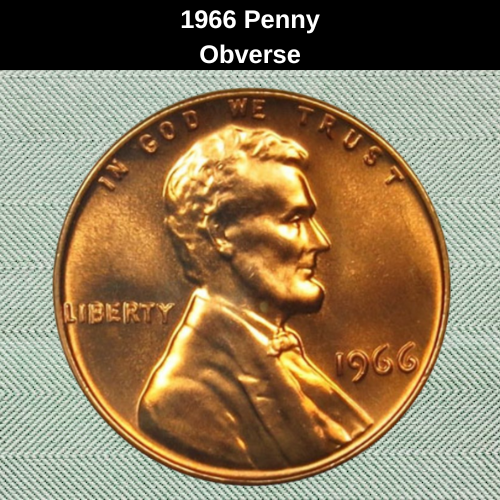
The design of the 1966 penny features a right-facing bust of Abraham Lincoln at its center. Surrounding this portrait are several key inscriptions:
- “IN GOD WE TRUST” is placed along the upper edge above Lincoln’s head.
- “LIBERTY” appears to the left of the bust.
- The date “1966” is shown on the right side, in front of Lincoln’s chest.
- The designer’s initials, “VDB” (for Victor David Brenner), are subtly engraved at the bottom, near Lincoln’s shoulder cut-off.
It’s important to note that none of the 1966 Lincoln cents have a mint mark, even though they were struck at multiple US Mint facilities. This was part of a deliberate strategy by the Mint during the mid-1960s to discourage coin hoarding.
The 1966 penny (reverse)
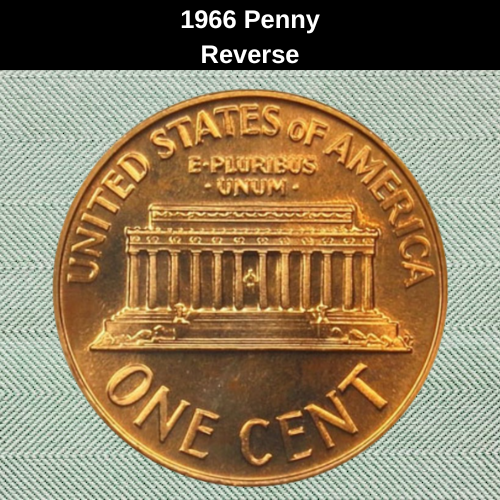
Just like all Lincoln cents issued after 1959, the reverse side of the 1966 penny features the Lincoln Memorial, with a small depiction of Lincoln’s seated statue visible between the central columns.
In addition to this iconic design, the reverse also includes key inscriptions:
- “UNITED STATES OF AMERICA” across the top
- The motto “E • PLURIBUS • UNUM •” just below the country name, with dots flanking “UNUM”
- The denomination “ONE CENT” at the bottom rim
You’ll also find the initials “FG”—representing designer Frank Gasparro—engraved to the right of the steps at the base of the Memorial.
1966 Penny Specifications (Key Details)
- Face Value: $0.01 (One Cent)
- Composition: 95% Copper, 5% Tin and/or Zinc
- Thickness: 0.0598 inches (1.52 mm)
- Shape: Round
- Diameter: 0.75 inches (19.05 mm)
- Weight: 0.1097 ounces (3.11 g)
- Edge: Smooth (Plain, no reeding)
These specifications remained standard for Lincoln cents of the era, including those minted in 1966.
Additional Features of the 1966 Penny
The 1966 Lincoln Memorial cent features Abraham Lincoln’s profile on the front and has several distinct physical characteristics:
- Thickness: 0.059843 inches (1.52 mm)
- Weight: 0.109702 ounces (3.11 g)
- Edge: Plain (smooth, without reeding)
- Composition: 95% copper and 5% tin and/or zinc
- Diameter: 0.75 inches (19.05 mm)
These specifications were standard for one-cent coins at the time, and they remained consistent throughout much of the Lincoln Memorial series.
Grading the 1966 Penny
The value of a 1966 penny depends heavily on its condition, which is measured using the Sheldon Coin Grading Scale. This system ranges from 1 to 70, with higher numbers indicating better preservation and finer details. Most 1966 pennies in circulation today fall into the lower grades due to wear, but uncirculated pieces are still found.
Here’s a breakdown of the scale:
| Grade # | Description |
|---|---|
| 1 | Basal State-1 |
| 2 | Fair |
| 3 | Very Fair |
| 4–6 | Good |
| 7–10 | Very Good |
| 12–15 | Fine |
| 20–30 | Very Fine |
| 40 | Extremely Fine |
| 50 | About Uncirculated |
| 60 | Mint State (entry level) |
| 65 | Mint State (gem) |
| 70 | Mint State (perfect) |
Circulated coins in the “Good” or “Fine” range have visible signs of wear but still hold some collectible value. Uncirculated coins, classified from MS60 to MS70, are more valuable, especially those with vibrant color and sharp detail. Always refer to a trusted grading guide or professional service to get an accurate assessment of your coin’s condition.
1966 Penny Value Guide and Mintage Information
In 1966, the U.S. Mint produced a massive 2,188,147,783 Lincoln pennies — yet none of them carry a mint mark, regardless of their origin. This decision was intentional, part of a short-term policy (1965–1967) aimed at discouraging coin hoarding during a nationwide coin shortage.
Mint Breakdown (All Without Mint Marks)
| Mint Location | Type | Quantity Minted |
|---|---|---|
| Philadelphia | Regular Strike | 811,100,000 |
| Denver | Regular Strike | 991,431,200 |
| San Francisco | Regular Strike | 383,355,000 |
| San Francisco | Special Mint Sets | 2,261,583 |
Although many collectors assume 1966 pennies without a mint mark were only from Philadelphia, in reality, all three major mints (Philadelphia, Denver, and San Francisco) contributed to the production of business strike coins. Only San Francisco produced the SMS (Special Mint Set) coins, which have a sharper, satin-like finish and were not intended for general circulation.
These SMS coins are more collectible, especially in higher grades or with cameo/deep cameo finishes, and can fetch much higher prices compared to circulated business strikes.
If you’re checking the value of a 1966 penny, always consider:
- The coin’s condition (use the Sheldon Scale)
- Whether it’s a regular business strike or SMS
- Any unique errors or variations
1966 No Mint Mark penny (regular strikes)
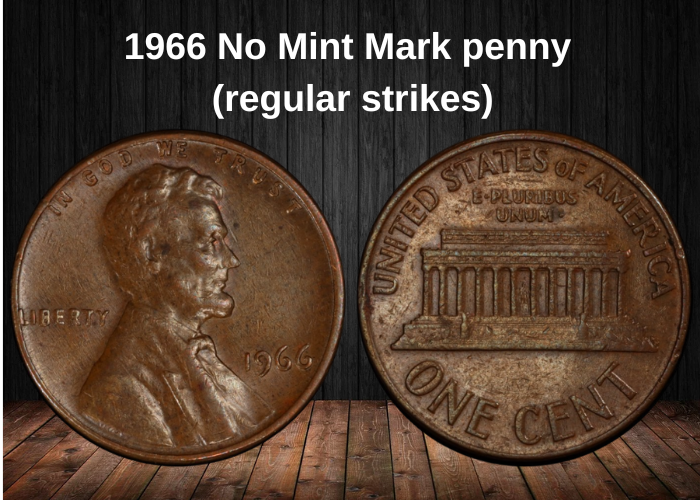
Although all 1966 Lincoln cents lack a mint mark, only 811,100,000 were actually struck in Philadelphia. The remaining coins were minted in Denver and San Francisco, but due to the no-mint-mark policy of the time, most people — including many dealers — treat them as if they all came from Philadelphia.
Because you can’t tell the mint origin by looking at the coin, its value is mainly determined by condition, especially for red-toned (RD) examples, which are the most desirable among collectors.
Market Value by Grade (Red Coins)
| Grade (MS) | Estimated Value |
|---|---|
| MS 62 | $6 |
| MS 63 | $7 |
| MS 64 | $10 |
| MS 65 | $18 |
| MS 66 | $35 |
| MS 67 | $950 |
Prices increase sharply at higher grades, especially for coins with exceptional luster and few blemishes. While tone (Red, Red-Brown, or Brown) slightly affects typical prices, auction results show that standout coins can fetch far more:
- An MS 65 Red-Brown (RB) sold for $200 in 2022.
- An MS 68 Brown (BN) example reached $320, also in 2022.
- Most impressively, an MS 67 Red (RD) penny brought in a whopping $6,463 at auction in 2012.
If you’re looking to buy, sell, or grade a 1966 penny, pay special attention to color, surface quality, and grading certification, as these factors play a major role in determining real market value.
Let me know if you’d like me to format this into a table for your website or create a section for SMS (Special Mint Set) coins too.
1966 penny (Special Mint Set)
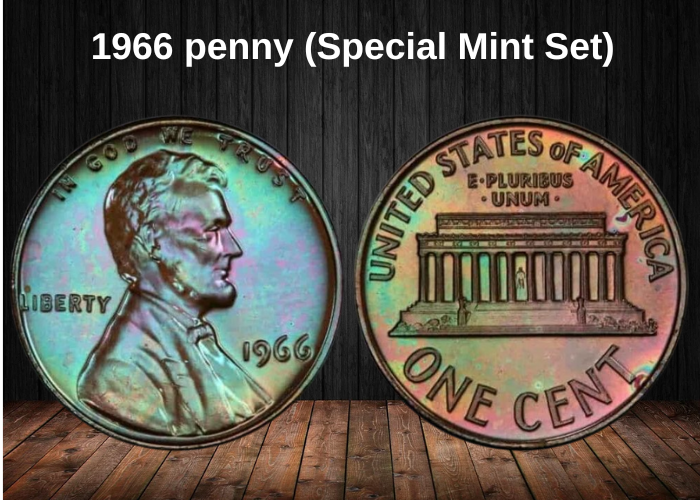
Just like the cents minted in 1965 and 1967, the 1966 Lincoln penny was issued without proof coins. Instead, the San Francisco Mint produced a total of 2,261,583 Special Mint Set (SMS) coins for collectors. These SMS coins were not intended for everyday circulation, and although not as sharp as traditional proofs, they were still of higher quality than regular business strikes.
Because these coins were preserved from wear, most remain in excellent condition today.
Value of 1966 SMS Pennies (Red Finish)
- SP 65 to SP 67: Typically range from $3 to $14
- SP 68: Valued around $100
- Highest auction record: A red SP 69 SMS penny sold for $863 in 2001
- Red-brown and brown tones: Usually go for under $300
SMS Cameo (CAM) Value Estimates
Coins with cameo contrast are generally more valuable due to their frosted designs and mirror-like fields. Prices vary based on grade:
| Grade (SP CAM) | Estimated Value |
|---|---|
| SP 65 | $175 |
| SP 66 | $250 |
| SP 67 | $750 |
- Record Price: A SP 67 CAM sold for $2,585 in 2014
- SP DCAM (Deep Cameo) coins are even more prized, with values around $1,750 for high-grade specimens.
If you own or are seeking a 1966 SMS penny, checking for deep cameo effects, red toning, and grade certification will help determine its true collector value.
Let me know if you’d like a visual price chart or a comparison with the 1965 and 1967 SMS penny values too.
Rare 1966 Penny Errors List
The Lincoln penny series is famous for having a wide range of error coins, and the 1966 Memorial cents are no exception. Many of these coins feature unique flaws or minting mistakes. Some of these errors are easy to spot without any tools and tend to be more valuable than regular examples. On the other hand, minor imperfections that require close inspection or a magnifying glass are generally less valuable on the market.
Doubled die obverse
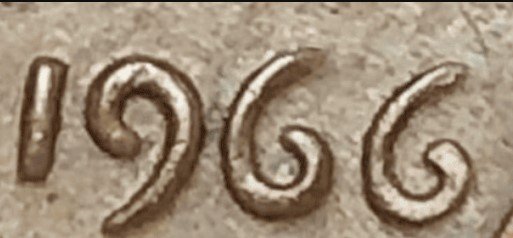
When a die displays signs of misalignment or duplication, it can create Doubled Die Obverse (DDO) errors on 1966 pennies. These flaws often appear on inscriptions, particularly noticeable in the word “TRUST” and the number “1” in the date.
Coins with this error usually sell for between $20 and $50, though more pronounced examples can reach $100 or more, depending on the visibility of the doubling. For example, an AU 53 brown 1966 penny with this error sold for $54 in 2020. However, some rare and well-preserved pieces fetch higher prices—such as a red MS 64 error cent that sold for $650 at auction in 2018.
Double strike with or without die adjustment
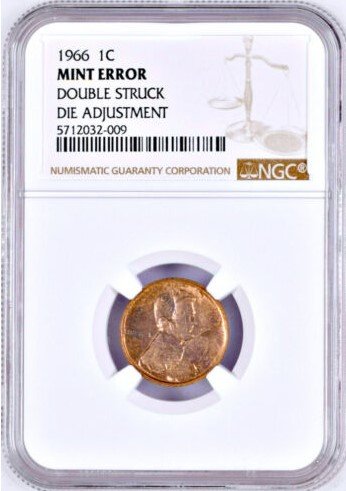
This error occurs when a penny is struck by a die twice, resulting in a double strike. Typically, these coins are worth about $65. However, in some rare cases, you may encounter a penny that has both a double strike and a die adjustment error. These combined errors can make the coin incredibly valuable, with one such piece being valued at around $11,500.
Penny struck on a 10-cent (dime) planchet
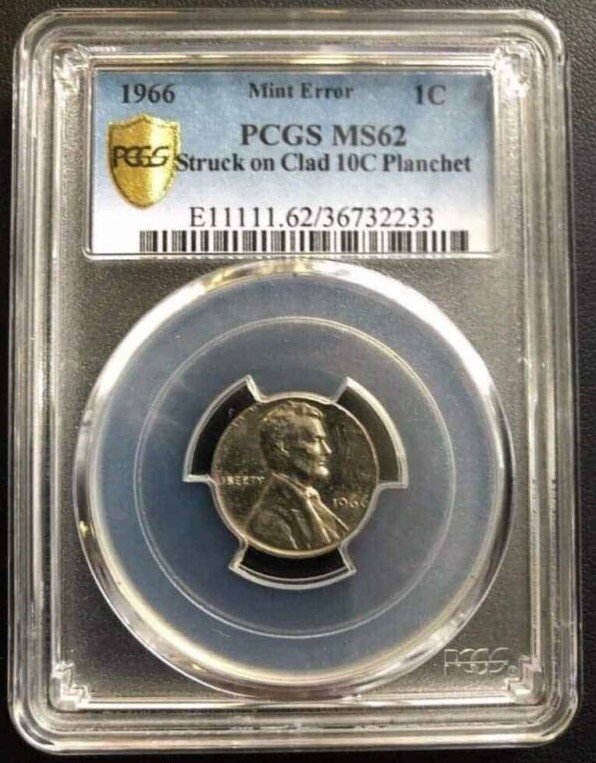
This unusual penny was struck on a dime planchet, giving it a distinctive silver color. It weighs 2.26 grams (0.080 ounces), which is slightly lighter than the standard 2.5 grams (0.088 ounces) of a typical penny.
Since dimes are smaller than pennies, with a diameter of 18 mm (compared to the 19.05 mm of a penny), you might notice that the “IN GOD WE TRUST” motto is cut in half due to the smaller size. Coins with this type of error can be valued around $300.
Penny struck on a split planchet

The 1966 Memorial cent struck on a split planchet is a rare error where the coin was struck on a planchet that had already split. These coins typically display striations or marks on the surface.
Since the planchet was split, the coin ends up being lighter than a standard penny, weighing about 1.9 grams (0.067 ounces) instead of the usual 3.11 grams (0.110 ounces). These error coins are valued at around $30 depending on their condition.
Retained Strike-through Error (1966 penny)
This error occurs when an object like a stapler wire, string, wire bristle, or wood chip becomes lodged on the planchet before it’s struck by the die. The result is a strike-through, where the object leaves an impression on the coin’s surface. These types of coins are quite rare, and depending on their condition, you could potentially sell one for $1,150 or more.
Half of Two Pennies Struck Together (Mated Pair Error)
This rare error happens when two pennies are struck together, but only half of each coin gets struck, leaving one side with a full design (e.g., Lincoln’s portrait) and the other side blank. While this error is uncommon, it’s worth at least $100, especially if you find a coin with Lincoln’s portrait on one side and the reverse side blank.
Obverse struck through a capped die
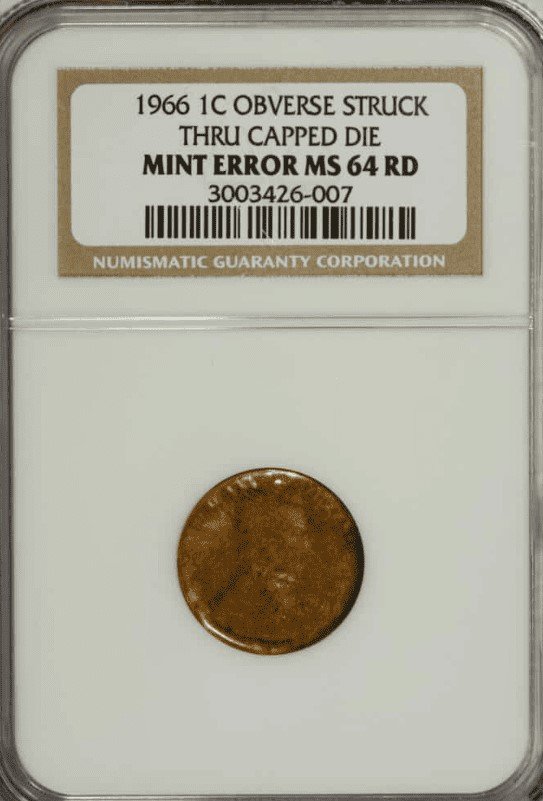
When a coin is struck through a capped die, the die itself is covered in a layer of metal, leading to incomplete or partial impressions on the coin. In the case of the 1966 penny, this error creates a ghostly or faint image of Lincoln’s portrait on the obverse, which is a defining feature of this mistake. Due to its uniqueness and rarity, such a coin can sell for at least $40, though prices can vary depending on its condition and the prominence of the error.
Die Break (Raised Bump or Line)
A die break occurs when a die becomes damaged, typically through cracks, during the minting process. As the die strikes the coin, it transfers the crack to the coin’s surface, creating a raised bump or line in the design. This type of error is common but does not usually add significant value to the coin. For a 1966 penny with a die break, you can expect to pay between $5 and $10, which is slightly higher than a regular penny’s value.
BIE (Die Crack Between B and E)
The BIE penny is another common error, where a vertical die crack appears between the B and E in the word LIBERTY, making it resemble a second I. While this is a familiar error among cents, it doesn’t command a high price. BIE 1966 pennies are typically valued between $5 and $10.
Where to sell your penny?
Now that you know the value of your penny, you might be wondering where to sell it. Don’t worry: here’s a guide to some of the best online platforms where you can easily sell your coins, along with their advantages and disadvantages.
Discover the best platforms for selling coins online (pros and cons).
FAQ About the 1966 Lincoln Penny
1. What is the historical significance of the 1966 Lincoln Penny?
The 1966 Lincoln Penny is part of the Lincoln Memorial series and marks a continuation of the copper composition used in U.S. pennies from 1909 until 1982. This coin falls within a significant period of U.S. coinage when the U.S. Mint was shifting other denominations, like dimes and quarters, to clad compositions (copper-nickel). While the penny retained its copper composition until 1982, the 1966 penny is important as it represents the ongoing production of the Lincoln Memorial design, which would later be replaced by the Union Shield design in 2010.
2. What is the composition of the 1966 Lincoln Penny?
The 1966 Lincoln Penny is made of:
- 95% copper
- 5% tin and zinc
This composition is typical for pennies minted from 1909 to 1982, which is mostly copper-based. It weighs 3.11 grams and measures 19.05 mm in diameter, maintaining the traditional penny specifications.
3. How many 1966 Lincoln Pennies were minted?
In 1966, the total mintage for the Lincoln Penny is as follows:
- Philadelphia Mint (no mintmark): 1,486,078,000
- Denver Mint (D mintmark): 1,436,050,000
The total mintage for the 1966 Lincoln Penny is around 2.92 billion, making it a common coin in circulation. This large mintage number means that the 1966 penny is not rare, but it’s still widely collected by enthusiasts for its place in the history of U.S. coinage.
4. What is the value of a 1966 Lincoln Penny today?
The value of a 1966 Lincoln Penny depends on its condition, with higher-grade coins being worth more. Here’s an estimate of its value:
| Condition | 1966 (No Mintmark) | 1966-D |
|---|---|---|
| Circulated | $0.01–$0.05 | $0.01–$0.05 |
| Uncirculated (MS60) | ~$0.10–$0.25 | ~$0.10–$0.25 |
| MS63 Red | ~$1–$2 | ~$1–$2 |
| MS65 Red | ~$3–$5 | ~$3–$5 |
| With major errors | Varies ($10–$100+) | Varies ($10–$100+) |
The 1966 penny is still relatively easy to find in circulated condition, and in most cases, it’s only worth its face value. However, uncirculated examples or coins with minting errors could be worth $3–$5 or more.
5. Are there any rare error varieties in the 1966 Lincoln Penny?
While the 1966 Lincoln Penny does not have any major design variations, a few error coins have been discovered:
- Die cracks: These can cause cracks to appear across the coin’s surface, especially along the edges or in the lettering.
- Off-center strikes: Occur when the planchet is not aligned correctly during the minting process, resulting in a shifted design.
- Clipped planchets: Where a portion of the coin is missing due to a blanking error.
- BIE error: A die crack between the “B” and “E” in “LIBERTY” may look like an “I”.
These types of error coins can increase the value of the 1966 penny, particularly if the error is rare or the coin is in uncirculated condition.
6. How do I identify a high-grade 1966 Lincoln Penny?
A high-grade 1966 penny should exhibit the following characteristics:
- Sharp, clear details: The design of Lincoln’s portrait and the wheat stalks on the reverse should be fully defined with little to no wear.
- No scratches or abrasions: A high-grade coin should have a smooth surface with few or no marks caused by contact or handling.
- Shiny luster: Uncirculated coins will exhibit a reflective, shiny surface that has no significant tarnish.
- Full rims: The rim should be sharp and undamaged, without signs of wear.
Coins that are graded MS-65 or higher should be nearly flawless and retain their original mint luster and details.
7. Is the 1966 Lincoln Penny worth collecting?
While the 1966 Lincoln Penny is not particularly rare, it can still be valuable to certain collectors:
- For error coin collectors: The 1966 penny is an attractive coin for error enthusiasts, especially if the coin exhibits any interesting mistakes like die cracks or off-center strikes.
- For those collecting high-grade examples: If you are building a high-grade collection of Lincoln Memorial pennies, the 1966 penny can be a valuable piece in uncirculated condition.
- For those interested in the history of U.S. coinage: As part of the last decades of the copper-based penny, it holds a historical value for collectors interested in U.S. coinage evolution.
Even though it’s not the rarest penny, the 1966 Lincoln Penny can still play an important role in various collections, especially when paired with coins from other years.


















































